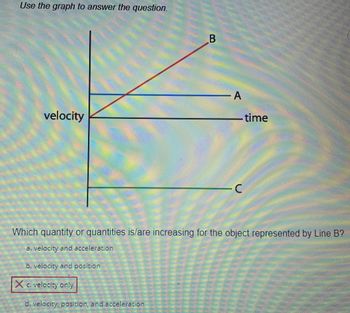
College Physics
11th Edition
ISBN: 9781305952300
Author: Raymond A. Serway, Chris Vuille
Publisher: Cengage Learning
expand_more
expand_more
format_list_bulleted
Concept explainers
Question
thumb_up100%
Use the graph to answer the question.

Transcribed Image Text:**Understanding Velocity-Time Graphs**
This educational section aims to explain how to interpret a velocity-time graph and apply this knowledge to determine changes in physical quantities.
### Graph Explanation
The provided graph is a velocity-time graph showcasing three different lines labeled A, B, and C. The x-axis represents time, and the y-axis represents velocity. Each line indicates the behavior of an object’s velocity over time.
- **Line A:** This line is horizontal, indicating a constant velocity over time.
- **Line B:** This line has a positive slope, indicating that the object's velocity is increasing over time.
- **Line C:** This line has a negative slope, indicating that the object's velocity is decreasing over time.
### Question and Analysis
**Question:**
Which quantity or quantities is/are increasing for the object represented by Line B?
- a. velocity and acceleration
- b. velocity and position
- c. velocity only
- d. velocity, position, and acceleration
**Answer:**
Option **c. velocity only** is correct, as marked with a red box around it.
### Explanation:
- **Velocity:** Line B shows an upward slope, which indicates that the velocity of the object is increasing over time.
- **Acceleration:** Since this line represents a uniform increase in velocity, the object has a constant acceleration. However, the question focuses on which quantities are increasing, and constant acceleration implies it is not increasing, just steady.
- **Position:** Position changes with velocity, but the graph does not provide direct information about the position itself.
Therefore, "velocity only" is the correct answer since the line indicates an increasing velocity over time without providing information sufficient to conclude the increase in other quantities like acceleration or position comprehensively.
Expert Solution
This question has been solved!
Explore an expertly crafted, step-by-step solution for a thorough understanding of key concepts.
Step by stepSolved in 2 steps

Knowledge Booster
Learn more about
Need a deep-dive on the concept behind this application? Look no further. Learn more about this topic, physics and related others by exploring similar questions and additional content below.Similar questions
- Show how to get that answer, show all the steps and formulaarrow_forwardRefer attached picture. Please check the answer in picture containing the question before submitting the solution.arrow_forwardPlease show the diagram and send the paper solution and answer it properly asap please fasterarrow_forward
arrow_back_ios
SEE MORE QUESTIONS
arrow_forward_ios
Recommended textbooks for you
 College PhysicsPhysicsISBN:9781305952300Author:Raymond A. Serway, Chris VuillePublisher:Cengage Learning
College PhysicsPhysicsISBN:9781305952300Author:Raymond A. Serway, Chris VuillePublisher:Cengage Learning University Physics (14th Edition)PhysicsISBN:9780133969290Author:Hugh D. Young, Roger A. FreedmanPublisher:PEARSON
University Physics (14th Edition)PhysicsISBN:9780133969290Author:Hugh D. Young, Roger A. FreedmanPublisher:PEARSON Introduction To Quantum MechanicsPhysicsISBN:9781107189638Author:Griffiths, David J., Schroeter, Darrell F.Publisher:Cambridge University Press
Introduction To Quantum MechanicsPhysicsISBN:9781107189638Author:Griffiths, David J., Schroeter, Darrell F.Publisher:Cambridge University Press Physics for Scientists and EngineersPhysicsISBN:9781337553278Author:Raymond A. Serway, John W. JewettPublisher:Cengage Learning
Physics for Scientists and EngineersPhysicsISBN:9781337553278Author:Raymond A. Serway, John W. JewettPublisher:Cengage Learning Lecture- Tutorials for Introductory AstronomyPhysicsISBN:9780321820464Author:Edward E. Prather, Tim P. Slater, Jeff P. Adams, Gina BrissendenPublisher:Addison-Wesley
Lecture- Tutorials for Introductory AstronomyPhysicsISBN:9780321820464Author:Edward E. Prather, Tim P. Slater, Jeff P. Adams, Gina BrissendenPublisher:Addison-Wesley College Physics: A Strategic Approach (4th Editio...PhysicsISBN:9780134609034Author:Randall D. Knight (Professor Emeritus), Brian Jones, Stuart FieldPublisher:PEARSON
College Physics: A Strategic Approach (4th Editio...PhysicsISBN:9780134609034Author:Randall D. Knight (Professor Emeritus), Brian Jones, Stuart FieldPublisher:PEARSON

College Physics
Physics
ISBN:9781305952300
Author:Raymond A. Serway, Chris Vuille
Publisher:Cengage Learning

University Physics (14th Edition)
Physics
ISBN:9780133969290
Author:Hugh D. Young, Roger A. Freedman
Publisher:PEARSON

Introduction To Quantum Mechanics
Physics
ISBN:9781107189638
Author:Griffiths, David J., Schroeter, Darrell F.
Publisher:Cambridge University Press

Physics for Scientists and Engineers
Physics
ISBN:9781337553278
Author:Raymond A. Serway, John W. Jewett
Publisher:Cengage Learning

Lecture- Tutorials for Introductory Astronomy
Physics
ISBN:9780321820464
Author:Edward E. Prather, Tim P. Slater, Jeff P. Adams, Gina Brissenden
Publisher:Addison-Wesley

College Physics: A Strategic Approach (4th Editio...
Physics
ISBN:9780134609034
Author:Randall D. Knight (Professor Emeritus), Brian Jones, Stuart Field
Publisher:PEARSON